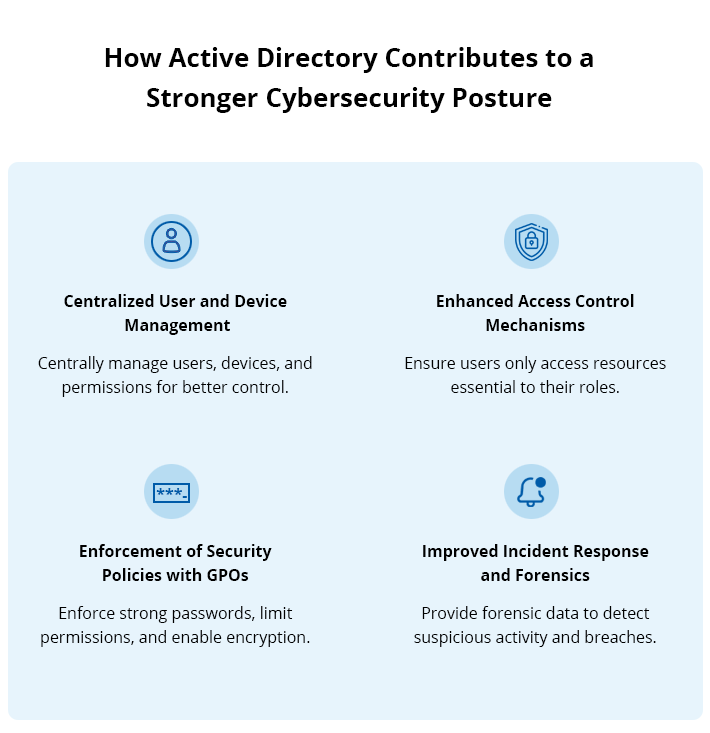Last Updated on December 17, 2024 by Deepanshu Sharma

Active Directory is often an underappreciated component in the cybersecurity ecosystem, yet it forms the backbone of identity and access management in many organizations. With cyberattacks becoming increasingly sophisticated, Active Directory is no longer just a tool for managing network resources, it is a vital player in defending against attacks, controlling user permissions, and protecting sensitive data.
But what exactly makes Active Directory so crucial in cybersecurity? This blog explores the essential role Active Directory plays in protecting against cyber threats and how it can be used to enhance overall network security.
What is Active Directory?
Active Directory is a directory service developed by Microsoft that allows IT administrators to manage and control the resources, users, and services within a network. It stores information about users, devices, and applications, ensuring that only authorized personnel have access to specific resources.
Active Directory’s Role in Strengthening Cyber Security Posture
The foundation of any cybersecurity strategy is identity and access management (IAM), and Active Directory is often at the center of an organization’s IAM infrastructure.
Here are some key ways in which AD contributes to a stronger cybersecurity posture:

1. Centralized User and Device Management
One of AD’s most significant contributions to cybersecurity is its ability to centralize the management of users, devices, and permissions. IT administrators can define and enforce security policies across the organization through a single interface. By managing all authentication and access policies centrally, AD reduces the likelihood of security gaps caused by misconfigurations or inconsistent policy enforcement across different systems.
This centralization allows for rapid response to potential security threats. For example, if a user’s account is compromised, an administrator can immediately disable the account or reset the password across the entire network from AD, minimizing the risk of further exploitation.
2. Enhanced Access Control Mechanisms
Active Directory enables administrators to implement fine-grained access control policies, ensuring that users only have access to the resources they need to perform their duties—also known as the principle of least privilege. This mitigates the risk of insider threats or malicious users gaining unauthorized access to critical systems and sensitive data.
Furthermore, AD supports multi-factor authentication (MFA), adding an extra layer of security. Users must provide two or more verification factors to gain access, significantly reducing the risk of brute-force attacks or credential theft.
3. Enforcement of Security Policies with GPOs
Group Policy Objects (GPOs) in AD allow administrators to enforce security policies across the entire organization. For example, GPOs can be used to mandate strong password policies, restrict user permissions, enforce encryption protocols, and limit access to removable devices (like USB drives). These GPOs help organizations ensure compliance with industry regulations like GDPR or HIPAA, as well as maintain a consistent security posture.
4. Improved Incident Response and Forensics
Active Directory is not just a tool for managing access; it also plays a crucial role in incident detection and response. By logging events such as user logins, password changes, and account lockouts, AD provides valuable forensic data that can be used to identify suspicious activity and track potential breaches.
Administrators can configure AD to integrate with Security Information and Event Management (SIEM) systems, enhancing the visibility of potential threats. For example, if multiple failed login attempts are detected in a short period, an alert can be triggered, allowing security teams to investigate potential brute-force attacks or compromised credentials.
Common Vulnerabilities in Active Directory
Despite its strengths, Active Directory can also be a significant target for cybercriminals. Since AD controls access to an organization’s most critical assets, compromising it could allow attackers to move laterally across a network, escalate privileges, and exfiltrate sensitive data.
Some common vulnerabilities and threats to AD include:
1. Weak or Inconsistent Password Policies
Poor password hygiene is one of the most common security risks. If AD does not enforce strong password policies (e.g., minimum complexity, length, and expiration periods), attackers can exploit weak passwords through dictionary or brute-force attacks.
2. Overprivileged Accounts
Another critical vulnerability is the existence of overprivileged accounts—especially those with administrative rights. If attackers compromise a privileged account, they gain unrestricted access to the network, which can be disastrous. AD administrators must regularly review and limit privileges based on the least privilege principle.
3. Pass-the-Hash Attacks
In a pass-the-hash attack, an attacker steals password hashes from a compromised machine and uses them to authenticate other services within the network without needing to crack the hash itself. Since AD handles authentication, it is often the primary target for these attacks.
4. Kerberos Ticket Forging (Golden Ticket Attack)
Kerberos is the default authentication protocol used in AD. In a Golden Ticket Attack, cybercriminals can forge Kerberos Ticket Granting Tickets (TGT) using the hash of the krbtgt account in AD. This gives attackers almost unlimited access to the domain, allowing them to persist in a network undetected.
5. Credential Theft from Domain Controllers
Domain controllers (DCs) are the servers that host the AD database. If attackers gain access to a DC, they can extract all credentials stored in AD, leading to complete network compromise. DCs must be protected with advanced security measures, such as enhanced monitoring and network isolation.
Download Whitepaper

Tips for Securing Active Directory
Given AD’s critical role in cybersecurity, it is essential to implement best practices to protect it from both external and internal threats. Below are some recommended measures:
Enforce Strong Password Policies
Implement strict password policies through GPOs, requiring minimum password complexity, length, and expiration periods. Additionally, consider using passwordless authentication methods such as biometrics or smart cards to further enhance security.
Limit Privileged Access
Apply the principle of least privilege to limit administrative rights to only those who absolutely need them. Regularly review user permissions and disable accounts that are no longer in use. Consider implementing privileged access management (PAM) solutions to add extra security layers around admin accounts.
Implement Multi-Factor Authentication (MFA)
Enabling MFA is one of the simplest and most effective ways to secure AD. Even if an attacker gains access to a user’s password, MFA adds an additional verification step that can thwart the attack.
Monitor for Anomalies and Integrate with SIEM
Active monitoring of AD events, such as login failures, permission changes, and account lockouts, is crucial for early detection of suspicious activities. Integrate AD logs with SIEM tools to automate threat detection and response.
Regularly Patch and Update AD Systems
Outdated software is a common entry point for attackers. Ensure that AD, its components, and the operating systems of domain controllers are always up to date with the latest security patches.
Conduct Regular Audits
Regularly audit AD to identify and remove stale accounts, inactive users, and unnecessary permissions. Periodic reviews help maintain security hygiene and prevent potential security gaps.
Strengthening Security in Hybrid and Cloud Environments
Many organizations, these days, are adopting hybrid environments, mixing on-premises infrastructure with cloud services. Azure Active Directory (Azure AD) extends the capabilities of on-prem AD into the cloud, offering additional security features tailored for modern cloud environments.
Azure AD supports features like Conditional Access, which grants access to cloud resources based on factors like location, device compliance, and risk level. This means that even if someone’s credentials are compromised, they won’t be able to access cloud resources unless they meet specific security criteria.
Additionally, Azure AD integrates seamlessly with other cloud security tools, providing organizations with a comprehensive solution for managing identities across both on-premises and cloud environments. As organizations continue to adopt cloud technologies, Azure AD helps maintain the same level of security, ensuring that identities are protected regardless of where they are being used.
Conclusion
Active Directory may not always be in the spotlight, but it is undeniably a foundational component in modern cybersecurity. From managing identities and access to integrating with security tools and defending against privilege escalation, AD plays an indispensable role in protecting organizations from a wide range of cyber threats.
As cybersecurity threats continue to evolve, so too will the role of Active Directory. Organizations that prioritize securing their AD environments, by implementing MFA, auditing accounts, and integrating with modern tools, will be better positioned to fend off cyberattacks and safeguard their digital assets.
If you want to know more about how Lepide can help in Active Directory security, schedule a demo with one of our engineers today.


 Group Policy Examples and Settings for Effective Administration
Group Policy Examples and Settings for Effective Administration 15 Most Common Types of Cyber Attack and How to Prevent Them
15 Most Common Types of Cyber Attack and How to Prevent Them Why AD Account Keeps Getting Locked Out Frequently and How to Resolve It
Why AD Account Keeps Getting Locked Out Frequently and How to Resolve It
